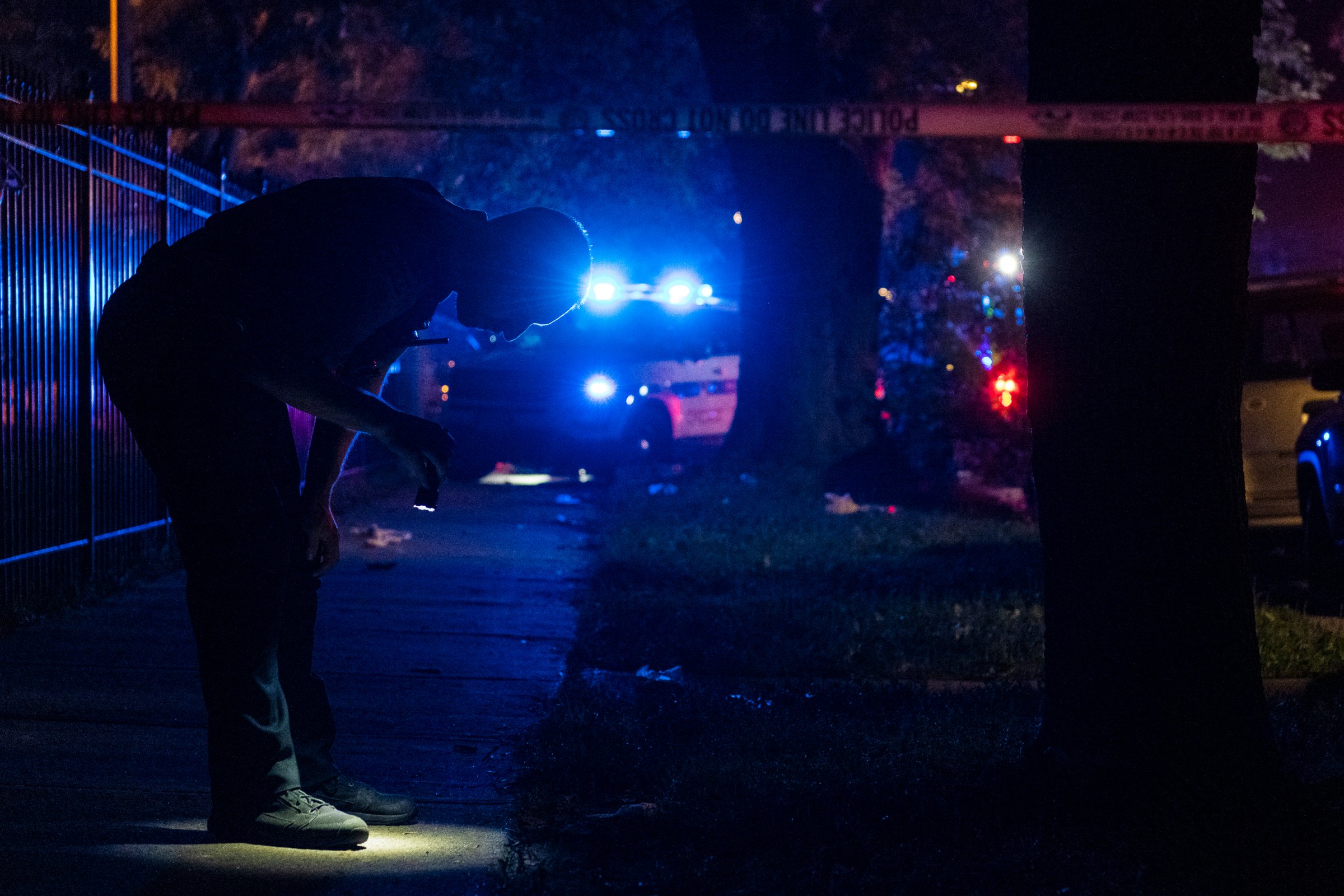
Chronic stress, trauma exposure, frequent threats of violence and the relentless grind of gun crimes’ impact: A recently-released report from the University of Illinois Chicago reveals in stark terms the strain and struggles that many frontline violence prevention workers face as they try to combat gun violence.
In 2022, Chicago is coming off another record year of homicides, similar to many other major cities across the U.S. 797 people were killed in 2021 with 3,677 non-fatal shootings—an increase from the 772 homicides and 3,383 non-fatal shootings in 2020. Nationally there were over 44,000 deaths as a result of gun violence and over 40,000 injuries, according to the Gun Violence Archive.
“I didn’t realize how much this job takes a toll on you,” one worker told the report’s researchers. “I was actually driving to work one day… and I had heard of nervous breakdowns, right? But man, I just started shaking and crying. I had to pull over.”
Read more: FBI Data Shows a Surge in Murders in 2020. That’s Not the Full Story
Street intervention work, which includes violence interrupters and outreach workers, focuses on interrupting the cycle of violence that has plagued many inner-city communities. These workers are members of the local community who have a certain level of credibility and can in theory foster relationships with a population that is both at-risk and very difficult to reach.
Violence interrupters are increasingly seen as an integral part of a push for more community-led policing efforts and police reform, but there is a lot of pressure that comes with that for those on the ground.
Researchers interviewed 36 violence prevention workers in nine Chicago neighborhoods that struggle with crime. (Rather than conducting their survey with pre-determined questions, the researchers focused on the workers’ stories and lived experiences, and had them describe in their own terms the impact of their work.) Their perspectives were illuminating and sobering; the study found that many deal with post-traumatic stress disorder (PTSD) and related issues as a result of witnessing shootings and their aftermaths, as well as engaging with victims of violence and family members related to victims.
In their responses, some of the workers also described being patronized by other healthcare professionals over their lack of formal education. Other workers’ concerns stemmed from having to come in close contact with representatives of police departments and the wider criminal justice system, having potentially been through the system themselves—and still facing stigma therefrom.
“We’re always going to be Black and Brown to law enforcement. We’re always going to look like a gang member to the rival gang,” another worker said, according to the study. “We’re always going to be ex-felons, or former incarcerated people that people look at with less regard, or don’t take our words seriously. Or see our line of work as insignificant.”
This presents particular challenges—that are likely to be exacerbated as programs grow in scope and prominence—since many proposed reform models call for increased collaboration between police, healthcare professionals and violence prevention workers.
And while this survey only focuses on Chicago, it’s likely emblematic of what many other frontline violence prevention workers are facing.
“[Violence intervention] is a stigmatized profession. Most people don’t even acknowledge street intervention as a profession,” Dr. Kathryn Bocanegra, the study’s principal investigator, tells TIME. “Because they are primarily Black and Brown men and women who have been through the system, people think they’re just thugs with a job.”
Bocanegra, who previously led a violence prevention organization in Chicago, explains that the trauma many of the workers go through can lead to burnout—and leave them desensitized to violence. This can also lead to not only physical health issues but mental struggles as well.
“If they’re in this work as part of their path to redemption and restoration, but the work is constantly retraumatizing them, is it worth it?‘ Bocanegra says.
Nationally, cities and the federal government have begun investing in programs like violence prevention centers to help address the root causes of gun violence. But the workers interviewed in Chicago said that they were underpaid and without the proper resources to care for themselves, let alone their communities. Without more engagement and support for workers, the model likely isn’t sustainable in its current form.
Read more: The Toll of Unsolved Inner-City Murders in Chicago
According to an October 2021 report by the Giffords Law Center to Prevent Gun Violence, 75% of full-time community violence intervention workers make between $30,000 and $50,000. Within that income range, 60% make less than $42,000. Beyond that, however, Bocanegra says the workers brought up very basic things that could be done to improve their work situations—greater job security, formal team support structures and access to mental health professionals, for example.
“What they were really indicating are basic, simple things that organizations can do to create a healing work environment. And if you have intact healthy workers, you’re actually going to have sustained violence reduction efforts at the community level,” Bocanegra says.
More Must-Reads from TIME
- Why Trump’s Message Worked on Latino Men
- What Trump’s Win Could Mean for Housing
- The 100 Must-Read Books of 2024
- Sleep Doctors Share the 1 Tip That’s Changed Their Lives
- Column: Let’s Bring Back Romance
- What It’s Like to Have Long COVID As a Kid
- FX’s Say Nothing Is the Must-Watch Political Thriller of 2024
- Merle Bombardieri Is Helping People Make the Baby Decision
Write to Josiah Bates at josiah.bates@time.com